Underground Meats goes whole-hog with local hand-crafted charcuterie
I discovered Underground Meats much in the same way the name suggests: not screaming from a sign or on a loud TV commercial but by word of mouth and a chance encounter on the patio at Mickey’s. There was beer, really tasty brats, and then there, in the corner; some kind gentlemen offering salami samples, including something I had never seen or tried: Goat Salami.
It’s really not that mysterious. Underground Meats is part of the Underground Food Collective (UFC), which is a group that focuses on all kinds of different artisan food projects. UM focuses on dry-curing sausages and whole muscles as well as producing some fresh sausage. The operation is a nod to the days when local production of foods was more prevalent.
UM and the UFC, while offering products for sale, also in a sense, offers a way for people to reconnect with and reclaim control over their food preparation. Classes are offered regularly on such topics as “Whole Hog Breakdown” at their facility in the Old Sugar Distillery on East Main Street in Madison.
It typically takes three days for a whole hog to be broken down into parts, ground up, and then made into sausage or salami. Those meats not offered fresh are then cured in a large Cure Box. UM offers both hand-crafted salamis and cured meats.
The crew at Underground Meats, which includes Matt, Jerry, Shawn, and Ben, took a few moments to answer some questions about how they got started, and among other things, the significance of curing meat in a basement.
Why the name Underground Meats? Are all the meats prepared in the
basement? Does the name suggest an alternative to how meats are offered
in today’s markets? Is there a meat revolution afoot?
The Underground name comes from our beginnings. We were working out of a basement kitchen and we liked the sound of it, and felt that in some ways we could identify with certain underground movements. Also, traditionally the dry curing of meats was done in basements or caves, so we thought the name fit the concept and gave a nod to the tradition which we are working in.
What kind of meats do you offer?
We offer a variety of 12 or so cured products. In retail stores around Madison (Jenny Street Market, Steve’s Wine Market, Metcalfe’s Hilldale, and the Willy Street Co-Ops) we offer Saucisson Sec, Goat Salami, Peperone, Pancetta, Spanish Chorizo, ‘Nduja (a spicy salami spread), and Tuscan Salami. Fromagination offers a number of our products, since they sell our stuff in bulk.
Our meats also appear on the menus at restaurants around town, including Bradbury’s, Capitol ChopHouse, the Old Sugar Distillery, Pig in a Fur Coat, Sardine, and the Weary Traveler. And Salvatore’s Tomato Pies in Sun Prairie makes a killer pizza featuring our peperone, in case you haven’t made it out there to try it yet.
What meats do you offer in raw form versus some level of processing? ie salami, sausage, etc.
You can buy a variety of our fresh products (sausages mainly, but occasional pates and the like) at the East Side Farmers Market every Tuesday. We also offer meat CSAs (Community Supported Agriculture), which always includes several fresh products. UFC‘s new restaurant Forequarter on Johnson Street will feature loads of Underground Meats, fresh and cured.
What don’t people understand about meat?
This question would have been easier to answer five years ago, but now consumers are so much more educated and are demanding quality, ethically-raised meat, and the market has started to respond to that. I’m really impressed by how many people I meet who are curing meat in their basement or purchasing whole animals to process themselves.
I think the largest piece of misinformation out there right now with regard to meat involves nitrate vs. celery powder use. We make use of synthetically derived nitrites and nitrates in our products. This ensures quality, safety, and straightforward regulatory compliance. Products labeled “Nitrite-free” and “uncured” are misleading: they do contain nitrites. As a technical work-around, producers, instead, use celery juice powder – a “natural flavor” – that actually contains a high level of organic nitrate, which converts to nitrite by the bacteria in starter cultures and in saliva.
What is more, products that contain celery juice powder tend to have significantly higher quantities of nitrites than those made with conventional curing salts. We know how much we add and ensure that it meets the minimum and maximum standards.
Why would people come to Underground Meats versus the traditionally known outlets?
The one advantage we have is that there aren’t many companies in the Midwest doing what we do. We cure whole muscle and salamis as well as make fresh products. Right now there are maybe five other companies in the US who have a product line like ours. Also, we use heritage breed pigs (Red Wattles and Tamworths) that are pasture-raised and fed a diverse diet, and we process the whole animal to make our product. We are constantly testing and experimenting with our product to improve it. The increase in quality in the last 12 months has been exciting to see.
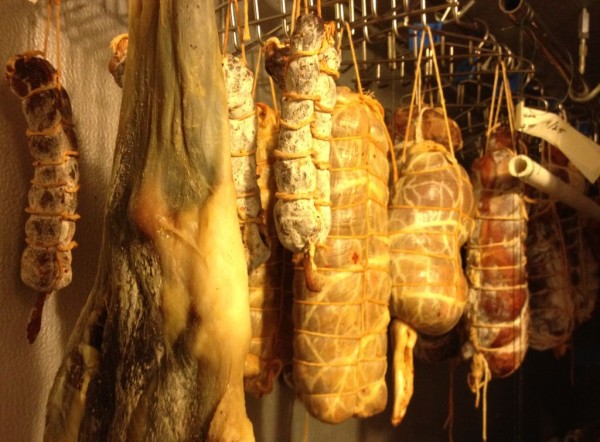 Is the neighborhood butcher on a comeback?
Is the neighborhood butcher on a comeback?
Yeah, the demand to have more precision and quality in meat cutting is coming into demand. It is really nice going to a counter and talking to someone who knows where the meat comes from, how it was raised, how to cut it and how to cook it. Butcher shops are such a great community resource if you want to cook good delicious food.
In regards to Charcuterie, what do you offer that other shops don’t? What makes it unique?
Our product line is really diverse. We are putting out seven products into retail and up to 12 into wholesale. You won’t really find that anywhere in the Midwest. We also have developed a bunch of products using goat and there isn’t a single US producer who offers a goat salami.
You offer classes in meat preparation—what skills do people need aside from avoiding slicing or severing their digits?
We mostly offer whole hog breakdown classes where people get a chance to butcher a half hog. I think the great thing about this is that people get to see where all the cuts come from and how they come off the animal. It is really helpful in cooking as well as planning menus. Further, if you ever want to cut up a whole hog for home use, this class will help you save a bunch of money because you won’t end up wasting any of the product
The cut of the meat is important. How much do people ignore pre-flavoring their meats before cooking it?
Brining pork is the single most important thing that is missed when cooking pork. It will make a huge difference.
Give us a few tips you wish all amateur chefs would follow after taking your products home.
- Don’t boil your fresh sausage first – poach it till the temperature gets to 140F and then finish it on the grill till it hits 160F. You will end up with a much better product that doesn’t lose any of the juices.
- Let salamis come up to room temperature before you serve them. The flavor develops nicely and the mouth feel is much better.
- Use salamis as a way to enhance the flavors of vegetables and grains. You don’t need to eat tons of meat. Use it instead as a way to enhance vegetables. Our goal isn’t for people to consume more meat, but to consume meat that tastes better and is cared for in its entire process.
- Pick up some ‘Nduja and melt a bit into a pizza or pasta sauce. The pork and spice distributes throughout every bite. It will change your life.


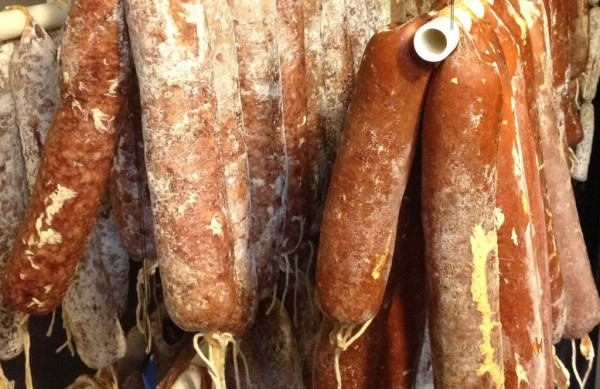
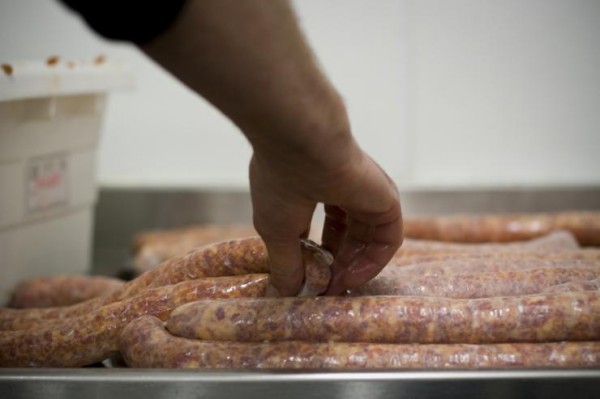
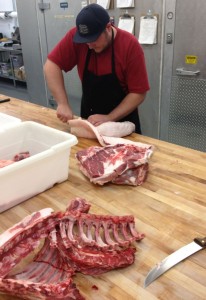
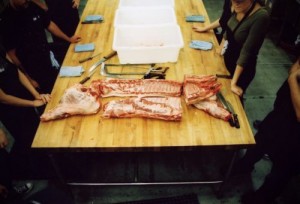
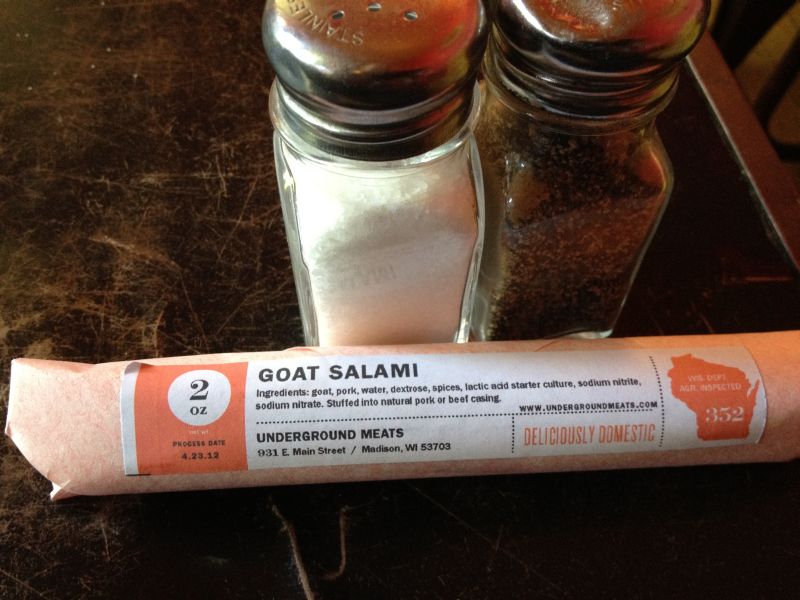
I haven’t heard about goat salami before, this is fantastic.